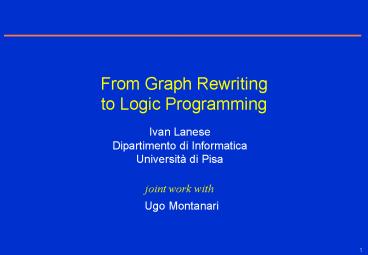From Graph Rewriting to Logic Programming - PowerPoint PPT Presentation
Title:
From Graph Rewriting to Logic Programming
Description:
Synchronized hyperedge replacement to model synchronization, reconfiguration and ... The transmission of an hidden name can provoke an extrusion ... – PowerPoint PPT presentation
Number of Views:74
Avg rating:3.0/5.0
Title: From Graph Rewriting to Logic Programming
1
From Graph Rewriting to Logic Programming
Ivan Lanese Dipartimento di Informatica Università
di Pisa
joint work with
Ugo Montanari
2
Outline
- Graph rewriting as a metamodel
- Graphical presentation of systems
- Synchronized hyperedge replacement (SHR)
- SHR with name mobility
- Translation into logic programming
- Ambients in SHR
- Modelling local names
- Conclusions
3
Motivation
- We propose to use
- Graphs as a natural way to model systems
- Synchronized hyperedge replacement to model
synchronization, reconfiguration and computation
4
A very general framework
- Synchronized hyperedge replacement can be used to
model - Network structures and reconfigurations
- Software architectures
- Process-calculi (?-calculus, Ambient calculus, )
5
A Strategy in Two Steps
- Local graph transformations
- Modular description of the system
- Easy to implement in a distributed environment
- Global constraint solving
- Allows complex synchronizations and rewritings
6
Edge Replacement Systems
- Productions A context free production rewrites a
single edge labeled by L into an arbitrary graph
R. (Notation L ? R)
L
R
H
3
3
4
4
2
2
1
1
7
Edge Replacement Systems
- Productions A context free production rewrites a
single edge labeled by L into an arbitrary graph
R. (Notation L ? R)
Rewritings of different edges can be executed
concurrently
8
Synchronized Hyperedge Replacement
- Synchronized rewriting Actions are associated
to nodes in productions. A rewriting is allowed
if its actions satisfy the synchronization
requirements associated to nodes
How many edges synchronize depends on the
synchronization policy
- Synchronized rewriting propagates
synchronization - all over the graph
9
Synchronized Hyperedge Replacement
- Hoare Synchronization All adjacent edges must
produce the same action on the shared node
- Milner Synchronization Only two of the adjacent
edges synchronize by matching their complementary
actions
10
Adding Mobility
- Synchronized rewriting with name mobility
- Allow declaration of new nodes in productions
- Add to an action in a node a tuple of names that
it wants to communicate - The names of synchronized actions are pairwise
matched and the corresponding nodes merged
11
Example
12
Logic Programming
13
Synchronized Logic Programs
- Goals have no functional symbols goal-graphs
- Synchronized clauses
- bodies are goal-graphs
- heads are A(t1,,tn) where ti is either a
variable or a single function symbol applied to
variables - Syncronized execution
14
The Ring-Star Example, I
15
The Ring-Star Example, II
16
A challenging example Ambient calculus
- SHR as a semantic framework for Ambient calculus
- Ambients naturally form trees
- Connectors to simulate Milner synchronization
- Computations formed by activity steps and
reconfiguration steps
17
The In transition
- nin m.P Q m R
- mnP Q R
18
Productions for the In transition
19
The In transition
20
The reconfiguration
21
Ambients in logic programming
The starting goal nil(v), c3(x,y,v), n(w,x),
c3(w,a,b), nil(b), c3(p,q,a), in_m.P(p),
Q(q), m(c,y), c3(c,r,d), nil(d), R(r) The final
result nil(v2), m(k2,v2), c3(k2,c2,d2),
nil(d2), c3(h2,r2,c2), R(r2), n(w1,h2),
c3(w1,a1,b1), nil(b1), c3(p1,q1,a1), P(p1),
Q(q1) Easy to execute with a meta-interpreter.
22
Adding restriction
Graphs can be extended with a restriction operator
- Transitions on hidden nodes are not seen from the
outside - The transmission of an hidden name can provoke an
extrusion - The SHR rules can be extended to deal with the
restriction operator
23
Back to logic programming
Logic programming with restriction
- An extension of logic programming with the
restriction operator - Allows a uniform treatment of restriction to goal
variables and of anonymous variables - Introduce a step-by-step semantics of name
visibility - The synchronized version is in correpondence with
SHR
24
Conclusions and Future Work
- Graph rewriting as a general model
- An useful semantic framework for process-calculi
- Useful connections between SHR and logic
programming - Implementations of SHR systems
- Logic programming with restriction
- General synchronizations for graph rewriting
25
A Notation For Graphs
- Ring Example
26
Transitions as Judgements
Formalization of synchronized rewriting as
judgements
- Transitions
?
? G1 ?? ?, D G2
?
?
? ? ? (A x N ) (x, a , y) ? ? if ?(x)
(a , y)
o
D is the set of new names that are used in
synchronization D z ? x. ?(x) (a , y), z
? ?, z ?set(y)
27
Transitions as Judgements
Formalization of synchronized rewriting as
judgements
Free names can i) be added to productions and
ii) merged Identity productions are always
available
- Transitions
- are generated from the productions by
applying the transition rules - of the chosen synchronization mechanism
28
From Synchronized Graph Rewriting to LP
PROLOG metainterpreter for synchronous execution

